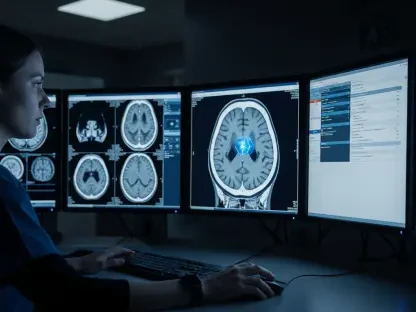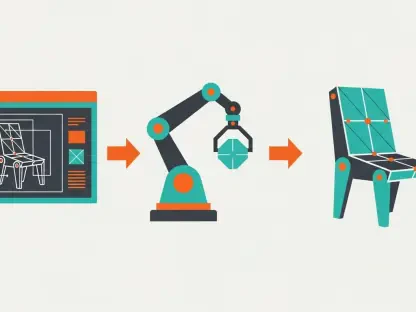Imagine a world where a routine mammogram not only detects existing cancer but also predicts a woman’s risk of developing it years before symptoms appear, potentially saving countless lives through early intervention and personalized care. Breast cancer remains a leading cause of death among women globally, with early detection being the cornerstone of improved survival rates. Yet, traditional methods often fall short, missing high-risk individuals due to reliance on limited factors like breast density. Enter artificial intelligence (AI), a transformative force in medical imaging that promises to revolutionize how risk is assessed and managed. This review delves into the cutting edge of AI-driven breast cancer prediction, spotlighting innovative models and their profound implications for personalized healthcare.
Understanding the Role of AI in Breast Cancer Risk Assessment
AI has emerged as a game-changer in the realm of breast cancer prediction, leveraging advanced algorithms to analyze medical images with unprecedented precision. At its core, this technology employs deep learning, a subset of machine learning, to process mammograms and identify subtle patterns invisible to the human eye. Unlike conventional approaches that depend heavily on patient history or singular metrics, AI offers a more nuanced evaluation, aiming to bridge gaps in early detection and enable tailored screening strategies.
The significance of this shift cannot be overstated, as traditional risk assessment tools often fail to account for the complexity of individual profiles. By integrating vast datasets and refining predictive capabilities, AI tools address these shortcomings, providing clinicians with actionable insights. This evolution aligns with broader trends in medical technology, where data-driven solutions are increasingly pivotal in enhancing patient outcomes and optimizing resource use in healthcare systems.
Key Features and Performance Metrics of AI Models
Image-Only Prediction Capabilities
Central to the latest advancements is the concept of image-only AI models, which assess breast cancer risk solely based on mammographic images. A standout example is Clairity Inc.’s CLAIRITY BREAST, an FDA-authorized tool that estimates a woman’s 5-year risk using a single screening mammogram. This approach bypasses the need for extensive patient data, making it a streamlined and accessible option for routine clinical use.
Performance metrics for such models are impressive, often measured by the area under the curve (AUC), an indicator of predictive accuracy. With reported AUC values around 0.72 for long-term risk prediction, alongside strong calibration—where predicted risks closely align with actual outcomes—these tools demonstrate reliability. This precision transforms mammograms from mere diagnostic snapshots into powerful predictors of future health threats, redefining their utility in preventive care.
Adaptability to Diverse Demographics
Another critical strength of AI breast cancer prediction lies in its adaptability across varied populations. Models have been trained on expansive datasets, encompassing over 120,000 mammograms from diverse groups in the United States and Europe. This broad training ensures that the technology can account for differences in age, ethnicity, and geographic risk factors, delivering consistent results across heterogeneous cohorts.
External validation further bolsters confidence in these tools, as real-world testing in multiple health systems confirms their applicability. Notably, the technology addresses emerging concerns, such as the increasing incidence of breast cancer in women under 50, by tailoring risk profiles to specific demographic needs. Such inclusivity underscores the potential for AI to promote equity in screening practices, ensuring that no group is left behind in the push for early detection.
Innovations Driving the Field Forward
Recent developments in AI for breast cancer prediction highlight a trajectory of rapid innovation, with companies like Clairity Inc. leading the charge. Presentations at major industry events have unveiled novel approaches to risk stratification, showcasing how AI can enhance decision-making in clinical settings. These advancements focus on integrating cutting-edge algorithms to refine accuracy and expand the scope of predictive analytics.
A notable trend is the move toward longitudinal monitoring, where serial mammograms are analyzed over time to track evolving risk scores. This dynamic approach paves the way for personalized screening protocols, adapting to changes in a patient’s profile. As clinical acceptance grows, AI is increasingly viewed as a complementary tool, seamlessly integrating into existing breast imaging workflows and reshaping standard practices.
Industry behavior also reflects a growing embrace of these technologies, with health systems and practitioners recognizing their value in enhancing patient care. Collaborations with leading academic institutions and researchers further fuel progress, ensuring that innovations are grounded in rigorous scientific validation. This collective momentum signals a future where AI-driven insights are integral to routine breast cancer management.
Real-World Impact and Clinical Applications
In practical settings, AI prediction models are already making a tangible difference by identifying high-risk women for targeted interventions. Deployed across numerous U.S. health systems and European screening programs, these tools enable clinicians to prioritize additional imaging or preventive measures for those most in need. Such applications illustrate the technology’s capacity to optimize care delivery on a large scale.
Specific implementations reveal the depth of impact, with validations spanning diverse clinical environments. For instance, AI has proven effective in enhancing mammogram utility, serving dual purposes of immediate triage for current cancers and long-term risk forecasting. This multidimensional use maximizes the value of a single screening, offering a cost-effective solution for healthcare providers.
Unique use cases further highlight the technology’s versatility, particularly in addressing underserved populations. Younger women, often overlooked by traditional models due to lower baseline risks, benefit from AI’s ability to detect early warning signs. By tailoring assessments to these groups, the technology fosters a more inclusive approach, ensuring broader access to life-saving interventions.
Challenges Hindering Wider Adoption
Despite its promise, AI in breast cancer prediction faces several technical hurdles that must be addressed for widespread implementation. Ensuring model accuracy across all cancer types, including invasive cancer and ductal carcinoma in situ (DCIS), remains a complex task, as does maintaining calibration for every demographic subgroup. These challenges necessitate ongoing refinement to guarantee reliability in diverse clinical scenarios.
Regulatory and market barriers also pose significant obstacles, with issues of cost and accessibility looming large. Integrating AI tools into existing healthcare workflows requires substantial investment and training, which may deter adoption in resource-constrained settings. Additionally, navigating approval processes and meeting stringent standards can slow the rollout of even the most promising technologies.
Efforts to overcome these limitations are underway, with partnerships between technology developers and esteemed institutions playing a crucial role. Collaborations, such as those involving Clairity Inc. with entities like Mass General Brigham, focus on addressing gaps through shared expertise and innovation. These initiatives aim to pave the way for seamless integration, ensuring that AI’s benefits reach patients without undue delay.
Looking Ahead at AI’s Potential in Breast Cancer Care
The future of AI in breast cancer prediction holds immense potential, with anticipated breakthroughs in longitudinal risk monitoring poised to transform screening paradigms. As models evolve to incorporate more dynamic data over extended periods, they could enable highly individualized care plans, adjusting to real-time changes in risk factors. This progression promises to enhance early intervention and reduce mortality rates significantly.
Beyond clinical outcomes, the technology stands to improve healthcare equity by prioritizing underserved communities and optimizing resource allocation in screening programs. By identifying high-risk individuals more efficiently, AI could alleviate burdens on overstretched systems, directing resources where they are most needed. Such advancements would mark a significant step toward universal access to cutting-edge care.
Global collaboration will be key to realizing this vision, with continued innovation driving the field forward. As researchers and industry leaders unite to tackle remaining challenges, AI is likely to become a cornerstone of proactive breast cancer prevention. The journey ahead involves not just technological refinement but also strategic planning to ensure that these tools are accessible and impactful on a worldwide scale.
Reflecting on the Path Forward
Looking back, the strides made in AI-driven breast cancer prediction marked a pivotal shift in how risk was understood and managed within clinical environments. The superior accuracy and adaptability of models like CLAIRITY BREAST stood out as a testament to technology’s capacity to outperform traditional methods. Their real-world applications demonstrated a clear edge in identifying at-risk individuals and enhancing mammogram utility across varied populations.
As the field progressed, the focus shifted to actionable next steps, including scaling these innovations to reach more diverse settings and addressing lingering barriers like cost and integration. Stakeholders needed to prioritize accessible solutions, ensuring that smaller clinics and underserved regions could adopt AI tools without financial strain. Strategic investments in training and infrastructure were essential to facilitate this transition.
Moreover, fostering ongoing dialogue among researchers, clinicians, and policymakers emerged as a critical consideration. Such collaboration could drive policies that supported equitable deployment while encouraging further refinement of AI capabilities. By building on the foundation laid in recent years, the medical community had the opportunity to cement AI as an indispensable ally in the fight against breast cancer, ultimately saving more lives through precision and foresight.









